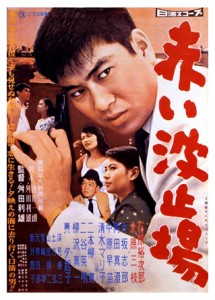AKA: Red Quay
Director: Toshio Masuda
Writer: Ichiro Ikeda, Toshio Masuda
Cast: Yujiro Ishihara, Mie Kitahara, Masumi Okada, Sanae Nakahara, Shiro Osaka, Hiroshi Hijikata, Hideaki Nitani
Running Time: 100 min.
By Kyle Warner
Dock worker Sugitaya steps off a boat to meet a man at the harbor. A crane swings low, crushes Sugitaya. Yujiro Ishihara’s gangster Jiro watches on, unimpressed. “Nasty way to go,” Jiro says. “Why can’t they be cool?” And with that, we can assume two things: 1) Sugitaya’s death probably wasn’t an accident and 2) Jiro’s a cynical bastard that’s obsessed with being cool.
From here on, Red Pier does its best to make it clear just how cool Jiro really is. Girls love him, guys fear him, and friends and enemies alike have great respect for him. He dresses suave, he has marksman skills with a gun and throws a blade like a pro dart throwing champion (there is such a thing! I did research). Jiro sings, he romances, he drives flashy cars… there’s almost nothing about Jiro that’s NOT cool. So, why don’t I give a damn?
The film built around the character of Jiro has some good ideas but it rarely commits to following through on them. Not long after Sugitaya’s untimely death, Jiro strikes up a relationship with the dead man’s sister (Mie Kitahara). She falls in love with Jiro but she also begins to suspect him. It’s probably the most dramatically compelling subplot of the film but it’s largely forgotten by the time we reach the final act. Much of the action takes place in the coastal city of Kobe, where Jiro is hiding out while things calm down in Tokyo. However, it soon becomes clear that the sins of Tokyo have followed him to Kobe, as hitmen come gunning for Jiro.
Red Pier’s three acts all have their own major points of emphasis. There’s very little organic flow to the story as it progresses. The beginning is about the death of Sugitaya and romancing the dead man’s sister. The middle is about the Jiro vs. the hitmen. The end is about watching out for the law. The lack of cohesion makes for an episodic storyline, and because I didn’t take to the main character, I found the movie rather dull as a result.
Character development for the ultimate bad boy antihero always requires great writing and perfect casting to avoid being boring or goofy. The mistake that’s made in Red Pier is that too much time is spent explaining that Jiro’s cool while not giving him enough of a chance to prove it with his actions. Considering the dialogue that introduces the character, one expects Jiro to be coldblooded and mean. Prepare to be disappointed: he often acts like a petulant child instead of a hard-nosed gangster. One scene even features Jiro hiding beneath a blanket so that he may avoid making a difficult decision.
Too much of the film relies on the star power of leading man Yujiro Ishihara (Crazed Fruit). Yujiro Ishihara was a very cool actor. Though not handsome in any traditional way, Ishihara still became a major heartthrob back in the day, playing action heroes and also making an impact as a recording artist. If you went to movies in Japan in the 50s and 60s, you understood that Yujiro Ishihara was a big deal. Red Pier knew that and I think they coasted on his star power, giving Ishihara a chance to do his thing but never providing enough material to make the film ever truly come together. An audience member of today with no understanding of who Ishihara was may be very confused as to why Jiro, a well-dressed brat with a gun, is so loved and respected by all. Ishihara was cool. Jiro? Not so much.
While I didn’t like Ishihara’s Jiro, I appreciated the work put in by supporting players Mie Kitahara and Shiro Osaka. Kitahara (Crazed Fruit) plays Sugitaya’s sister and Jiro’s primary love interest in the film. The film denies her a chance to become much more than one side of a conflicted romance, but Kitahara brings unexpected humanity to the part. Shiro Osaka (Pigs and Battleships) plays the detective whose job it is to prove Jiro’s guilt, but he’d rather see Jiro change his ways so that he won’t have to. Detective Noro is Red Pier’s most likable and complete character. It’s kind of a shame there wasn’t more of him in the film.
Red Pier is an early film for director Toshio Masuda, who’d spent the first few years in the film business as a screenwriter and an assistant director. In Red Pier, Masuda shows a few visual flourishes (I quite liked the slanted camerawork) but the storytelling is messy. Released that same year, Masuda’s Rusty Knife (also starring Ishihara and Kitahara) is a more polished effort by the director. He would continue to hone his skills from there. In time, Masuda would rise to become one of Japan’s most popular directors, with such films as Like a Shooting Star, the popular anime Space Battleship Yamato, and the rarely seen/often spoke of Prophecies of Nostradamus.
I found Red Pier to be rather disappointing but I enjoyed getting another look back at classic Japanese cinema. Red Pier is the second film included in Arrow Video’s Diamond Guys Vol. 1 DVD/Blu-ray release (read my review for Voice Without A Shadow). It’s not so bad that I consider its inclusion on the set a dealbreaker—not at all—I just wouldn’t recommend watching it first, personally.
Kyle Warner’s Rating: 5/10



